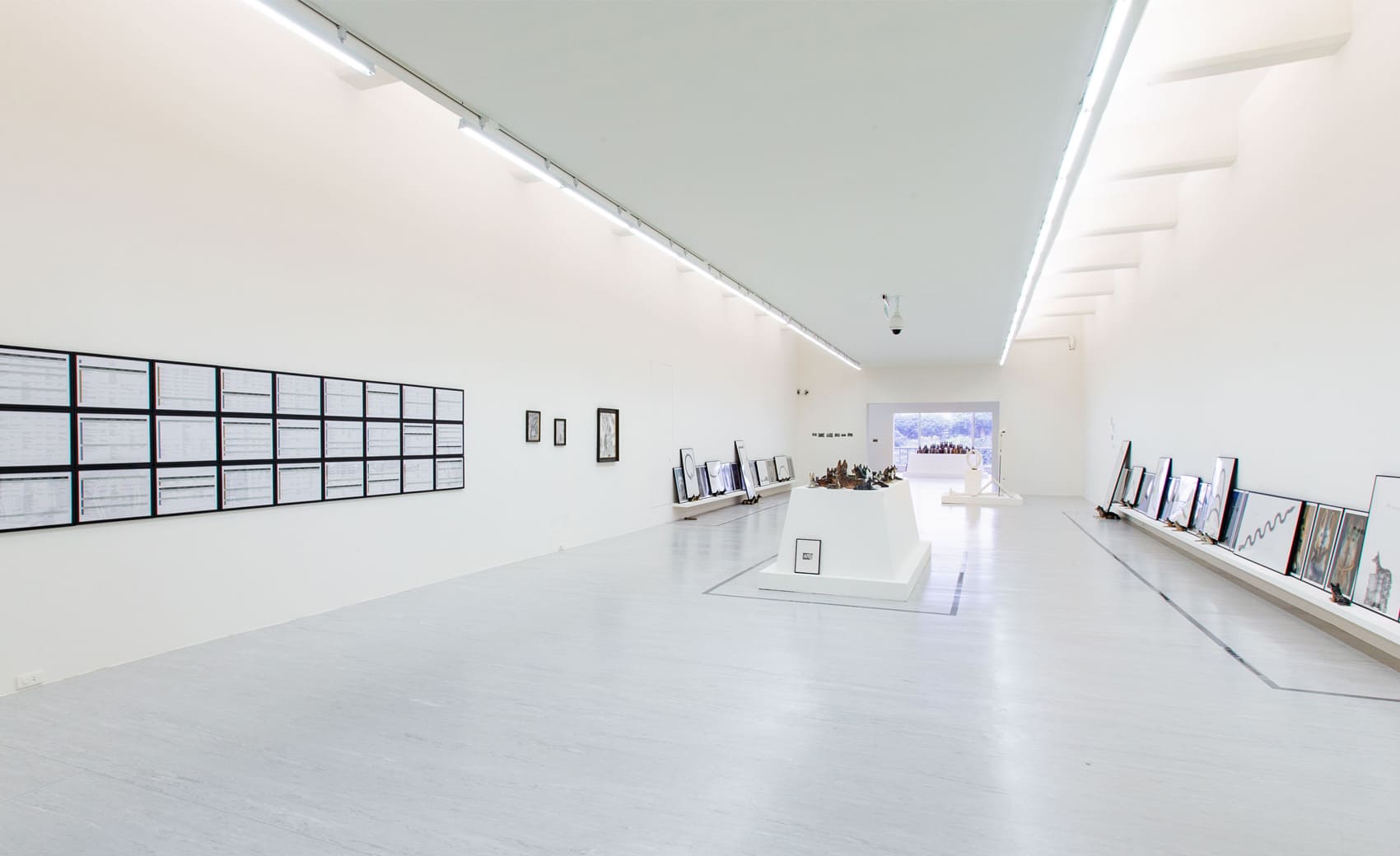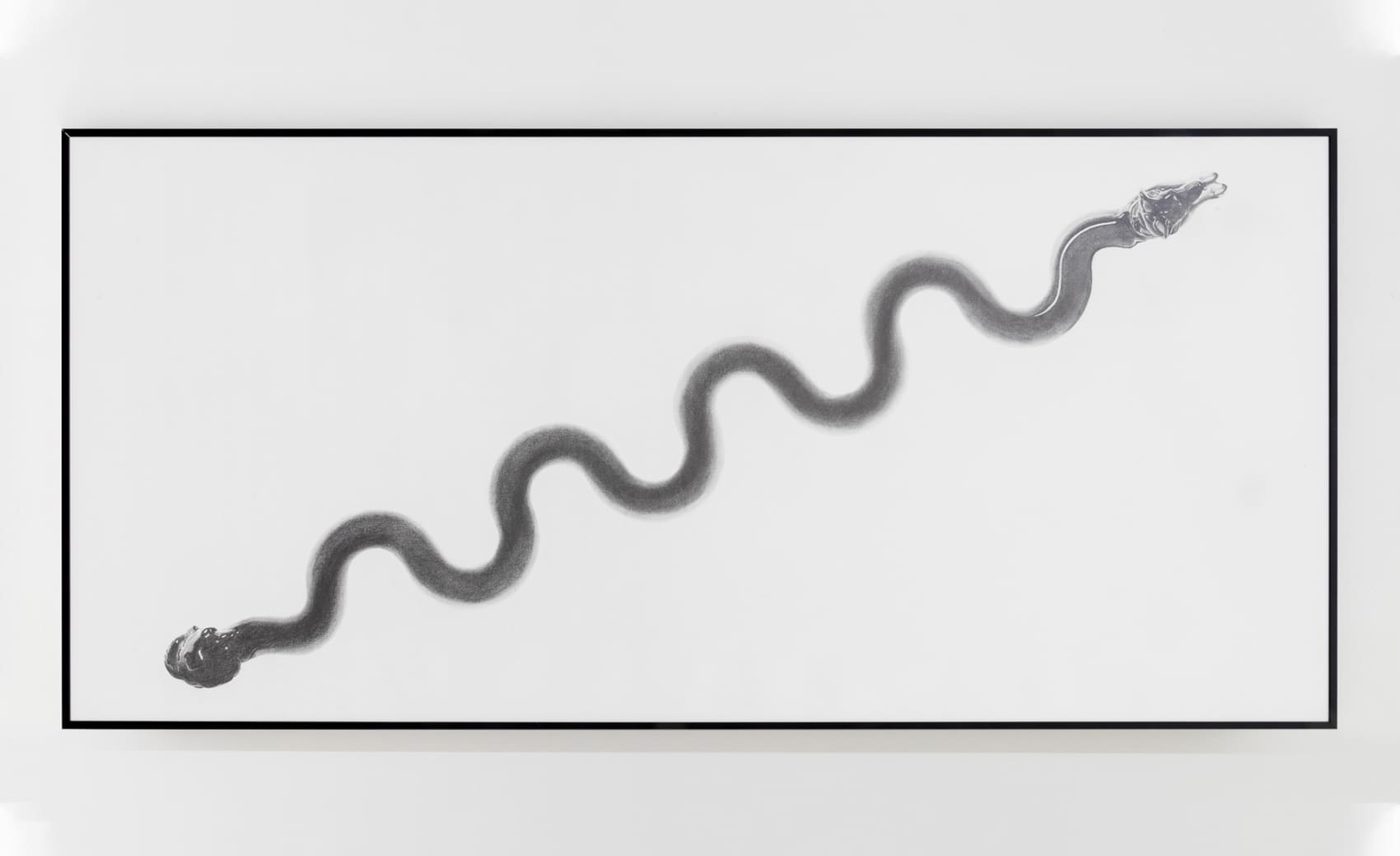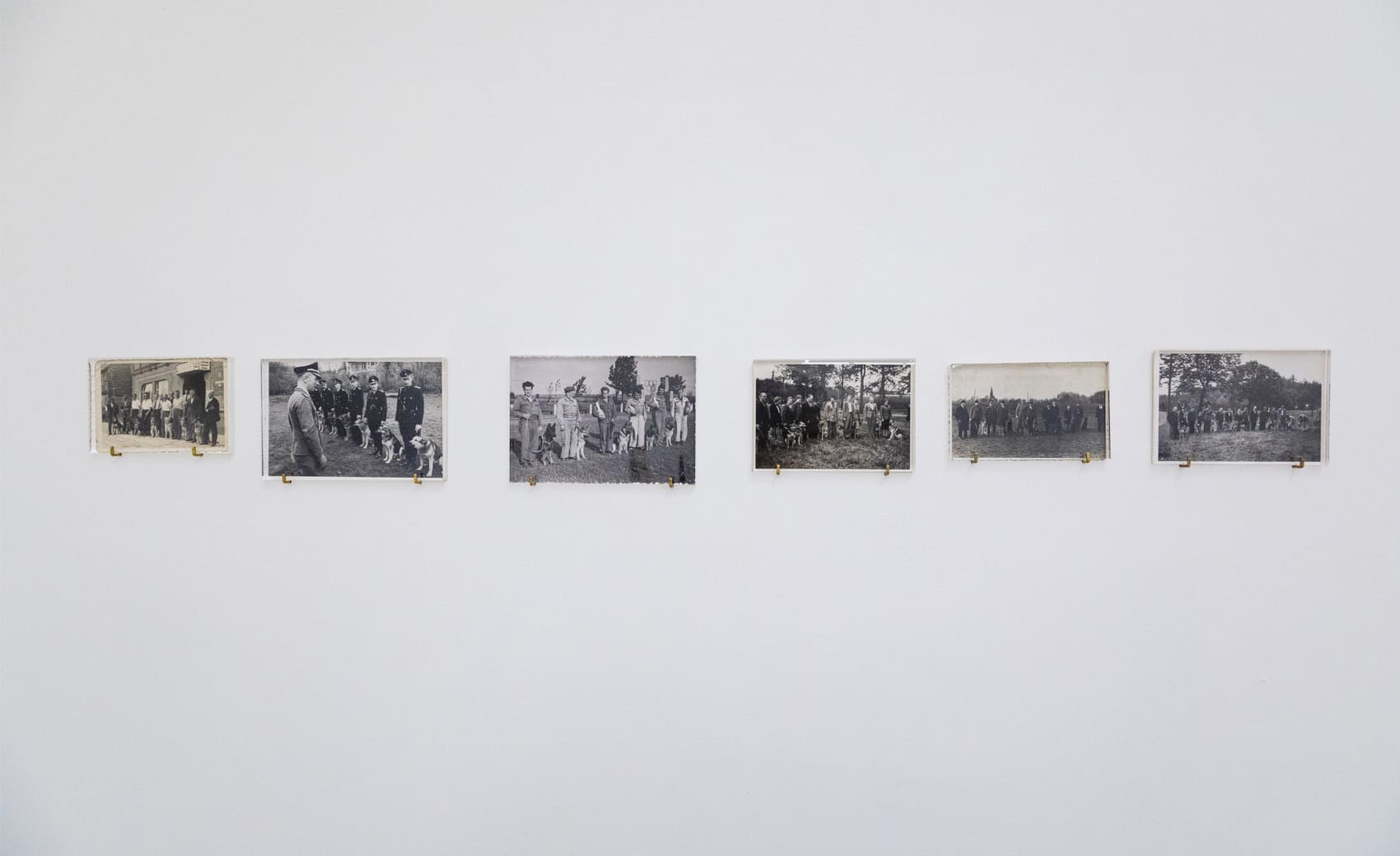從個人自2012年起大量收藏的鶯歌產製狼犬撲滿出發,將規模化生產的陶瓷撲滿擺設,連結至純種狗於標準範本下的繁殖跟認證,追溯德國牧羊犬(德國狼犬)作為德意志民族認同建構之純種狗繁殖育種,以及日本統治臺灣時期效法德意志帝國、引入狼犬作為軍犬,且延續至國民政府遷臺後持續服務軍警等脈絡,也納入歷史上其他犬隻與國族主義交會的對照。展覽以瓷偶收藏與創作、素描、錄像、攝影、銅雕及文件層層指涉隱喻,從陶瓷到狗,再從狗的育種對照到製造者的歷史,交集出物種訓育、國族建構、戰爭與殖民史的論述空間。
The exhibition begins with the artist’s extensive collection of shepherd dog-shaped money banks produced in Yingge, which he has started collecting since 2012. He links these mass produced ceramic money banks to the breeding and certification of purebred dogs, and traces the history of German Shepherd Dogs (GSD) to examine the history of how the German Empire used the breeding of purebred GSD to construct national identity; how the Japanese colonial regime in Taiwan copied the German Empire and introduced GSD as military dogs; and how the Nationalist Government continued using GSD as service dogs, such as police and military dogs. The artist also includes in the discussion the interrelations between other canine breeds and nationalism in history for comparison. In the exhibition, the audience sees the artist’s ceramic collection of dogs as well as a number of sculptures, drawings, videos, photographs, bronze sculptures and documents, which form metaphoric layers that are intricately linked. From ceramic sculptures, to canines, to comparison of canine breeds and pedigrees, to the history of breeders, the exhibition creates an elaborate space of discourses about species discipline, national construction as well as the history of war and colonization.
吳權倫,1985年生於臺南,國立臺南藝術大學造型藝術研究所碩士,現居與工作於柏林與臺南兩地。創作以自然與文明,生態與政治,媒材與數位間的不斷改寫、折衷與矛盾為背景,運用多元媒材,發展以觀念與研究為基礎的裝置作品。作品曾於臺北市立美術館、國立臺灣美術館、光州美術館、上海外灘美術館、柏林貝塔寧藝術村展出,並受邀參與2014年台北雙年展。 藝術家個人網站 https://www.wuchuanlun.com
WU Chuan-Lun
Born in Tainan in 1985, Wu Chuan-Lun holds an MFA from the Graduate Institute of Plastic Arts, Tainan National University of the Arts. He currently lives and works in Berlin and Tainan. The ever-going changes, compromises and contradictions informing the relations between nature and civilization, ecology and politics as well as materials and the digital have formed the general background of his art practice. He employs a diverse range of media to create conceptual and research-based installations. His works have been shown at Taipei Fine Arts Museum, National Taiwan Museum of the Arts, Gwangju Museum of Art, Rockbund Art Museum and Künstlerhaus Bethanien; and he was also featured in the 2014 Taipei Biennial. https://www.wuchuanlun.com
臺北市立美術館
林平
余思穎
李瑋芬
高子衿、劉惠平
吳權倫
Magdalena PLUTA
Skulpturengießerei Knaak
Uta KOLOCZEK (manufactory)
Ross WANG
林明彥及團隊
Frauke STEINHÄUSER
林于嫣
Hanns-Peter FRENTZ
erial Photography bw
TU 3D Lab
臺北市文化局與國家文化藝術基金會
何文安、吳權倫
章芷珩
陳寬育、朱峯誼
陳寬育、朱峯誼
台北市立美術館
關鍵字
- 陶瓷陶土
- 現成物
- 工藝品
- 肖像
- 攝影
- 裝置
- 錄像
- 品種表
- 素描
- 銅雕
- 臺座
- 遊戲
- 訓練
- 障礙
- 套圈圈
- 跳環
- 收藏
- 釉
- 毛
- 金牌
- 高度
- 文獻
- 育種家
- 移情
- 育種
- 早期
- 國族
- 歷史
- 品種
- 血統
- 血緣
藝術家談作品
個展承載吳權倫近年觀察藝術圈以創作探尋淵源的好奇,也希望觸動觀眾的探尋之心,生活中種種事物、關係及局面的形成,多半其來有自,並非本就如此。
採訪及文字整理文/吳家瑀
若說生活中一切物質與文化基礎,是人類至今努力開拓文明、尋求歸屬的表徵,那麼是否能夠藉由物質與情感逆向追尋,為此彼找到各自來處?2019年個展,吳權倫從個人對寵物的情感出發,連結動物馴養、物種培育、陶瓷收藏及交易史,接引台德兩地國族政治;《馴國》歷經漫長的醞釀與創作過程,揭露的不僅是曖昧不清的歷史遺緒,還有投向過去、當下與未來的批判反思。
起源於生活中的小事
吳權倫的作品常常起始於生活小事。「呷布」是他在2009年收養的野狗,散步時常被問起品種,人們對寵物血統的執著,使吳權倫意外走進狗的世界系譜與建構邏輯。喜好收集鶯歌陶瓷老件的吳權倫,養狗後更加留意狗的造型陶瓷,對於鶯歌過往大量產製德國狼犬陶瓷撲滿的緣由漸生疑惑。這個未竟議題,直至吳權倫2017年到德國駐村,才因緣際會迎來完成計畫的天時地利。
狼犬陶瓷通俗氾濫、非屬稀罕,在學界乏人問津。回憶歷程,吳權倫笑說:「最好玩的是尋找鶯歌狼犬陶瓷背後的故事,過程其實是透過一種非常民間、庶民的方式」,藉助攀談老件攤商、尋訪藏家打聽消息,各種口耳相傳甚而天馬行空的說法拼湊線索。而面對資料龐雜,須取捨給予適宜觀眾的內容、權衡展覽規模的可見範圍,歷經許多掙扎與捨棄,吳權倫坦言《馴國》計畫形成充滿困難。
「馴」與「犬」召喚出的意義光譜
德國狼犬的馴育,牽引出德國國族主義、納粹種族優生概念,乃至猶太集中營與阿拉赫官瓷之間脈絡的糾結纏繞,使得「狼犬」從地方、鄉下,再到國家,具有不同的意義層次,這點吳權倫巧妙藉由英文同字異意的特性,呈現在展名「No Country for Canine」中;中文展名玩轉類似手法,《馴國》定名前夕,正逢台灣處於大選前充斥「亡國論」的選舉語言中,「馴」一字多音,其諧音使吳權倫聯想選舉左右國家未來存亡,因此「馴國」之名不僅包含人類對自然的馴化,乃至國家誕生、維運產生的各式限制規訓,同時隱含「尋國」抑或「殉國」的焦慮。
《馴國》配合空間以十字型交叉雙軸線佈局,作品〈當收藏成為育種–台灣〉安放在十字架頂端位置,由鶯歌狼犬陶瓷撲滿堆聚而成白色神壇,與盡頭另一端的歐洲狼犬陶瓷遙遙相望,揭開臺德兩地對話的論述基調;橫向軸線兩端各為一白一黑空間,白色展間子題「最白的白」,談論人對狗的馴化、育種、訓練,乃至文化意義和娛樂性質的轉化,最為展現戳刺國族議題的力道,它藉由展示納粹和軸心國日本圖像、陳列納粹陶瓷、考據和描繪純種德國狼犬,襯以場域的簡淨視覺,提煉暨折射出人類賦予給「白色」的集體欲望和記憶,一旁播放吳權倫與德國學者的對談,討論納粹意識形態與種族主義和德國牧羊犬育種之間的相似之處。與之相對,黑盒子展間將藝術家所想所思濃縮成兩支錄像,精簡陳述。
為呈現研究成果,《馴國》中使用錄像作為推動敘事、連貫思路的媒材,然而錄像對吳權倫來說是全新探索,不諳剪接、拍攝技術加上腳本困滯,讓他吃足苦頭,一開始陷入漫無目的四處拍攝,待到回工作室釐清,才逐漸理出敘事邏輯,從欲求精準按部就班到即興剪輯,打破他以往對影像製作流程的正規想像。
探尋事物的來處
《馴國》在錄像敘述中安插以「據說」開頭的障眼法,模糊相對肯定的考察結果和學說,意圖引發觀眾參與對話或挑戰知識的可能。吳權倫說,規劃展覽時,最害怕聽到「狗是人類最好的朋友」這句話:嚴肅的主題一旦被說得輕巧,就難以認真對待。因此對色調格外走心,以黑白棕金藍統合《馴國》整體視覺,希望藉印象的植入使觀眾擁有記憶索引,避免展覽整體太過可愛而焦點模糊,從而有了重新檢視生活的心思。個展承載吳權倫近年觀察藝術圈以創作探尋淵源的好奇,也希望觸動觀眾的探尋之心,生活中種種事物、關係及局面的形成,多半其來有自,並非本就如此。
評審談作品
覽主體包含狼犬的瓷偶品系與造型,呈現人與犬之間依存關係的文件及其美學詮釋,並藉著納粹育種的優生學論述指涉國族神話建構、戰爭與殖民史等議題。儘管手法相當質樸,卻開創出本地罕至的創作險路。
吳權倫個展《馴國》結合馴育動物與國族主義兩大主題,前者是德國狼犬從物種(犬)到品種(牧羊犬)的育種歷程,後者從臺灣鶯歌的陶瓷狼犬撲滿,追溯至德國納粹御用陶瓷廠也是集中營的勞動項目;透過日本、德國同為軸心國的背景,連結帝國在台徵用狼犬的集體記憶。展覽主體包含狼犬的瓷偶品系與造型,呈現人與犬之間依存關係的文件及其美學詮釋,並藉著納粹育種的優生學論述指涉國族神話建構、戰爭與殖民史等議題。儘管手法相當質樸,卻開創出本地罕至的創作險路。 (主筆/鄭文琦)
Wu Chuan-Lun’s solo exhibition, No Country for Canine, comprises two themes: animal breeding and nationalism. Regarding the former, the artist investigates the breeding history of German Shepherd Dog that has evolved from a (canine) species to a (shepherd dog) breed. Regarding the latter, the artist starts with the German Shepherd Dog porcelain coin banks produced in Taiwan’s Yingge and traces history of the labor work in Germany’s concentration camps that produced porcelains for a Nazi-designated porcelain brand, connecting the backdrop of Japan and Germany as the Axis to the collective memory of imperial Japan’s commandeering shepherd dogs in colonial Taiwan. The exhibition displays various groups and series of German Shepherd Dog porcelain in a wide range of postures, demonstrating archives about the codependence between humans and canines as well as their aesthetic interpretation. Meanwhile, the exhibition also hints at the construction of national myth, war and colonial history through the lens of eugenics employed by the Nazis in breeding. Although the approach is relatively straightforward, the exhibition reveals a creative route rarely seen in Taiwan. (Commentator: Rikey Tenn Bun-ki)








